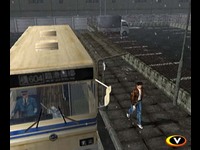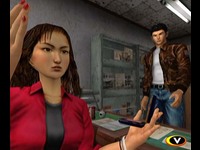|
|

|
PLATFORM
|
Dreamcast
|
BATTLE SYSTEM
|

|
INTERACTION
|

|
ORIGINALITY
|

|
STORY
|

|
MUSIC & SOUND
|

|
VISUALS
|

|
CHALLENGE
|
Easy
|
COMPLETION TIME
|
20-40 Hours
|
|
OVERALL

|
+ Admirably well-realized locale
+ Several memorable sequences
- Pretty darn boring sometimes
- Early parts are slow
- Not enough action
- Halfhearted localization
|
Click here for scoring definitions
|
|
|
Yu Suzuki got it into his head while researching the Virtua Fighter series to try something radically new in the video game world. Originally intended for the Saturn, Shenmue spent long enough in development that it wound up on Dreamcast after expending $47 million of Sega's funds for the task. With that kind of budget the game needed to sell in enormous quantities to just break even, and the single greatest disappointment of the Shenmue story may be how unlikely it is to ever see completion, though the game itself is hardly free of issues.
On November 29, 1986, Ryo Hazuki returned to his family home to witness his father being interrogated and murdered by a man named Lan Di. By threatening Ryo's life Lan Di managed to extract the location of something called the Dragon Mirror, which he took in addition to ending the life of Iwao Suzuki. This day has burned itself into Ryo's mind, and he now seeks to avenge the murder of his father. Doing so will require plenty of detective work.
Sega tried very hard to avoid labeling Shenmue as an RPG, calling it instead a Full Reactive Eyes Entertainment (FREE). The game certainly doesn't play like most RPGs, having more in common with adventure titles on the PC. The early parts of Shenmue feature almost no fighting and rely solely on Ryo wandering the streets of Yokohama talking to people. He asks everyone he meets the same question until someone finally has an answer, and with that information Ryo is able to wander the streets asking a different question.
Such repetitive busywork means that the plot advances in tiny fits and starts, only gaining some momentum at the end of the game. That makes sense since Shenmue as a series was supposed to incorporate sixteen chapters, and this game contains only the first. The core of this game's tale could have been told very quickly as Ryo makes his peace with the fact that he needs to leave Japan for Hong Kong in order to find Lan Di. Shenmue instead drags the proceedings out to fill up three GD-ROMs of material, and the frozen molasses pace is impossible to ignore.
 Regular bus service every half hour exists in Yokohama. Not where I live, of course.
Regular bus service every half hour exists in Yokohama. Not where I live, of course.
|
|
The constant questioning of everyone Ryo sees on the street does allow appreciation of how well-realized the Yokohama neighborhoods are. Some people will never give Ryo anything more than a brush-off, but even they have a daily routine to make them more than standard NPCs. The effect is less impressive when compared to later games such as Radiata Stories, but for 1999 Shenmue was superlative in its presentation of a bustling city filled with people going about their lives irrespective of the protagonist's quest.
Sega of America's localization unfortunately makes getting immersed in the districts of Yokohama rather difficult. The decision to keep all street signs and other types of writing in Japanese is understandable, just a touch annoying when the subtitles only appear as Ryo stops to zoom in on the location. Far more jarring is the often odd dialogue characters utter. The voice actors are a varied lot, with some being adequate and others being amusingly terrible, but the things they say don't always make sense. Ryo will utter one or two syllables to get a surprisingly detailed reply about why the respondent has nothing to say, which must have made more sense in the game's native language.
Realism was the goal in Shenmue, and for that reason Ryo must go home every night to sleep. He also needs to be mindful of the time, because some people and businesses are only available at specific hours. While this effort to be like the real world is admirable in the abstract, it's often annoying in practice. Without a way to advance time, Ryo is frequently stuck killing time until the clock strikes the right hour for him to progress. His sleeping habits cannot be ignored either, because he must manually run home every night. Often this puts a limit on how much can be accomplished on a day in the game, but there is no getting around it. The realism also takes a slight hit whenever Ryo gets stuck in a corner and shifts at stiff angles until he can move his way out, since walking backward is impossible.
Between running around and talking to people, Ryo will start to encounter the action elements of Shenmue. The game's cutscenes are often broken up with Quick Time Events that require pressing the right buttons to proceed, a device borrowed by other games in the years since. Actual fighting shows Yu Suzuki's familiarity with Virtua Fighter by deploying a variant of that combat system, except most of the time Ryo will be battling multiple adversaries. Some of these fights get challenging, but losing in Shenmue simply restarts the sequence so that players can try it until successful. Fighting is in any event a welcome injection of action into the gameplay.
 This woman looks like she's not particularly helpful. That's because she isn't.
This woman looks like she's not particularly helpful. That's because she isn't.
|
|
Certain parts of Shenmue are quite memorable, though not necessarily for the reason intended by the developers. Early on Ryo determines that, as Chinese people are foreigners in Japan, many of them must work on ships, which leads to the comical sight of him asking everyone he meets where sailors hang out. For a game that tried to be realistic having Ryo work at a job where forklifts race every morning is a jarring sight, but a fairly amusing one. Chasing the man who sold Ryo a worthless boat ticket and teaming up with another character to take on seventy opponents in a sprawling dockyard fight are legitimately exciting moments in the game, standing out from the frequently mundane wandering.
For the Dreamcast, Shenmue looks mighty impressive. Only by comparing its rather expressionless character models with those that have come out in the years since do they lose some luster, but at the time they were close to the pinnacle of what graphics could achieve. The detail of the environments Ryo explores is particularly well done. The goal of realism was not necessarily achieved, since in the world of Shenmue cats routinely walk blithely around dockyards with constant forklift activity, but the game came closer than anything else at the time. The music is also quite good — while much of the music is primarily atmospheric it does not become aggravating with repetition, and certain themes do a terrific job of establishing the mood.
Shenmue is easy to admire, and it certainly represents well the time when Sega wasn't afraid to do something strikingly different. The results are often pretty boring, though, reflecting the unfortunate truth that a game which strives for great realism risks demonstrating how monotonous and uninteresting real life can be. Playing Shenmue is a unique and sometimes rewarding experience, but hard to wholeheartedly recommend when it requires so much menial time wasting.
Review Archives
|









